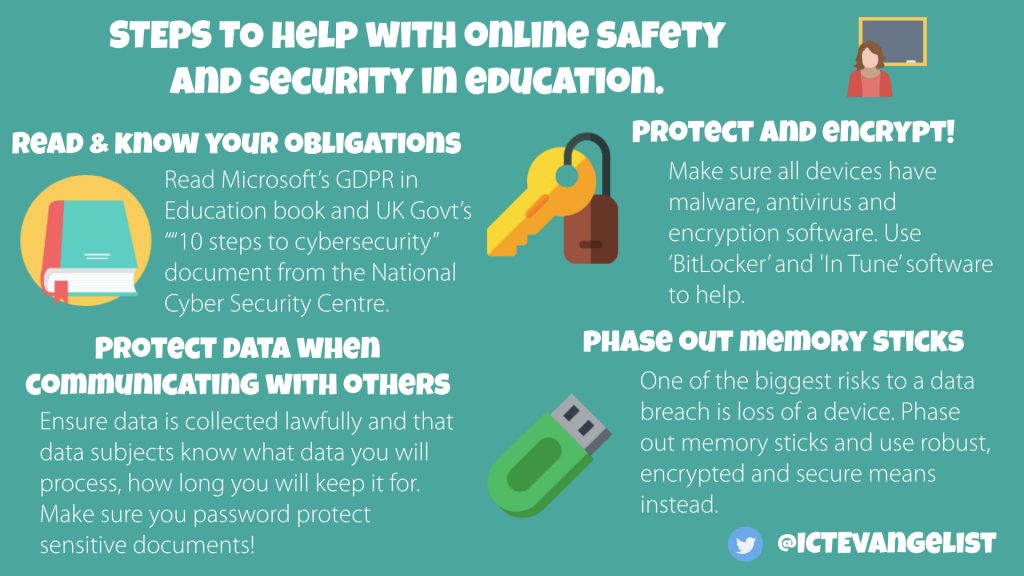
Online Safety and Security in a post

Never before have citizens in the UK had more rights. The introduction of the new General Data Protection Regulations (GDPR) in May this year brought about a number of changes that have had significant impact in schools. The best bit for me with it all has been the conversations around protecting children and their data that have had to happen because of it. The requirement for everyone to take more responsibility for the safeguarding of the sensitive data they hold in schools has been a positive one.
I will always remember the difficulty of ensuring all colleagues in one school I worked in moving away from USB sticks and ensuring complex passcodes for devices rather than just simple 4-digit codes; some even refused to have those because of the “inconvenience” having a secure password entailed. Just like it is our professional obligation as teachers to safeguard our learners in real life so it is our responsibility to ensure that we take care with their data in their digital lives too, when it relates to our professional work with them in loco parentis.

The deadline for GDPR may have passed but schools are still coming to terms with the changes. Just last night I read on Facebook about a school facing a Subject Access Request (SAR) from a parent. The ensuring conversation talked about the difficulty and time such a thing will take. There are lots of changes and it’s difficult to know exactly what to do and how to do it.
It is recognised that when organising trips into the world outside of school risk assessments are important and so how do you ensure you mitigate against risk for your learners around online safety, security, and data protection? Fortunately, there is lots of great advice and software around to help you as an educator not only find out about your obligations and what you can do but also how you can safeguard your learners too.
 Microsoft have a great blog titled GDPR: The five things teachers should do first which is a great read with some fantastic advice. Added to that their brilliant free eBook packed with great advice, the GDPR for Education book is worthy of a good read. Another great resource to check out for all schools is the DfE’s Data Protection Toolkit: For Schools.
Microsoft have a great blog titled GDPR: The five things teachers should do first which is a great read with some fantastic advice. Added to that their brilliant free eBook packed with great advice, the GDPR for Education book is worthy of a good read. Another great resource to check out for all schools is the DfE’s Data Protection Toolkit: For Schools.
One of the key ways that schools can help to safeguard learners is through the careful management of the devices that they use. Microsoft’s Intune is a device management solution that is competitively priced and gives some great features to help manage the devices in your school. Through their admin console it is possible for everyone to get groups of devices up and running very quickly. The admin portal you have access to gives options to help anyone, from a teacher in the classroom to network administrators to accomplish everyday things that you need to do with devices in classrooms.
As I know from personal experience, students can often forget their login passwords for devices and lots of time can be wasted with learners having to travel to a technician’s office to get their password reset. One of my favourite features in the console is SSPR (Self-Service Password Reset) which is something that can be done by a teacher in the classroom. This one little efficiency can help keep students from getting off-track while using their devices and lets you as a teacher concentrate on the important part of the job; your teaching and their learning.
Other features such as SSO (Single Sign On) for apps also means that learners will be more efficient in their logins to the crucial software you will want them to use. It has the additional benefit of ensuring that once authentication has taken place through logging in, through the SSO you can rest assured that their use of the software will be safe and secure.
 About the author
About the author
Mark Anderson is a former teacher and school leader and now award-winning author, blogger, speaker, thought-leader and trainer around all things to do with teaching, learning and effective use of technology in the classroom.
Mark firmly believes that education is a force for good and under his moniker of the ICT Evangelist he strives to demonstrate how technology is something that can help to make the big difference to the lives of learners and teachers alike.





